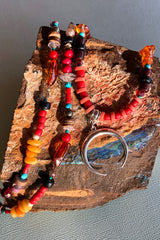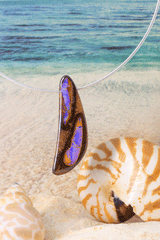Our New Australian Opal Necklaces
Opals has become our new favourite! unlike any other gemstone each opal has a wonderful individual range of colours and patterns, at Mombasa Rose we have sourced some divine local opals and turned them into statement necklaces.




https://www.mombasarose.com.au/collections/silver-gemstone-necklaces
Like most precious gemstones, opals take millions of years to form. A large amount of the world’s opals are formed in the Australian outback, while some are also sourced from Mexico, Ethiopia and Peru.
Opals were formed when seasonal rains soaked the dry, cracked soil and filled the fractures and cavities of the desert rocks. The running rain water carried with it stones of unusually high mineral composition. Over millions of years, these silica layers accumulated, forming beautiful polychromatic opal deposits for lucky miners to discover.



Opals have been celebrated for many, many years. In recent times there has been much added interest in our beautiful national stone. Opals have become the favourite of artisan and high-end jewellers, unlike any other gemstone each opal has a wonderful individual range of colours and patterns, opal is never boring and best of all it comes in a price range that is accessible to everyone.
Opal, the most beautiful and magical of all the gemstones, has been treasured from the beginning of civilization to the present day, and will be forever into the future. The word comes from various roots: Sanskrit 'Upala' (precious stone), Greek 'Opallios' (to observe color change) and Latin 'Opalus' (seeing jewel).
The Australian Aborigines have understood the opal's unique energy and beauty since the Dreaming times. They bestowed the name of 'Rainbow Serpent' upon this remarkable gem and described its creation: "The Creator took the colors of the rainbow, and put them into stone to make opal". Another story tells of the Creator travelling via a rainbow road to spread a message of peace on earth. With each step, the stones underfoot turned into tiny, tangible rainbows – opals.


https://www.lawsongems.com/collections/opal
There are other myths about the ancient gods involving opals. Zeus, the Greek king of the gods, was so happy when he defeated the Titans that he wept tears that turned into opals upon hitting the ground. The Indian Goddess of the Rainbow was reportedly so beautiful that many male gods sought her favour. Eventually, as a desperate act of escape from their advances, she turned herself into the rainbow-colored opal.
Traditions of other cultures display similar reverence. The Arabs believed that opals fell from heaven in flashes of lightning, that is how they received their fiery color. The ancient Greeks thought that opal conferred the gifts of foresight and prophecy. They would assist the wearer to lessen their inhibitions and reveal true feelings. Ancient Romans ranked opals above all other gemstones and paid high prices for the luxurious and fortune-bringing stones.
Archaeological evidence reveals that opal was mined in Virgin Valley, North America, over 10,000 years ago and used in artifacts in Kenya 6 thousand years ago. The ancient Greek Theophrastus who prepared the oldest extant book on precious stones, quoted his friend Onomacritus: "the delicacy of the opal remind me of a loving and beautiful child".
In the Roman world, when Mark Antony wished to present an opal ring to Cleopatra, the senator Nonius fled rather than give it up to him. And Pliny the famous author and natural philosopher, described his opal purchase: "having a refulgent fire of the carbuncle (ruby or garnet), the glorious purple of amethyst, the sea green of emerald, and all those colors glittering together mixed in an incredible way." During the same time, the Aztecs were mining opal in South and Central America.
Throughout the Middle Ages (5th - 14th centuries) opal was know as 'ophthalmios' (eye stone) due to a widespread belief that it was beneficial to the eyes. Blond women also wore opal necklaces around this time to protect their hair from losing its color. A Holy Roman Emperor included opals in his crown and Shakespeare mentioned the opal as "a miracle" and the "Queen of Gems". Queen Victoria wore opals throughout her life and delighted in presenting them to her friends and to other Royal Family members. Opal was discovered in Australia at Lightning Ridge in the late 1880s and the first shaft was dug in 1901 or 1902. Today it is the national stone of the country and Australia supplies 95% of the world market.





